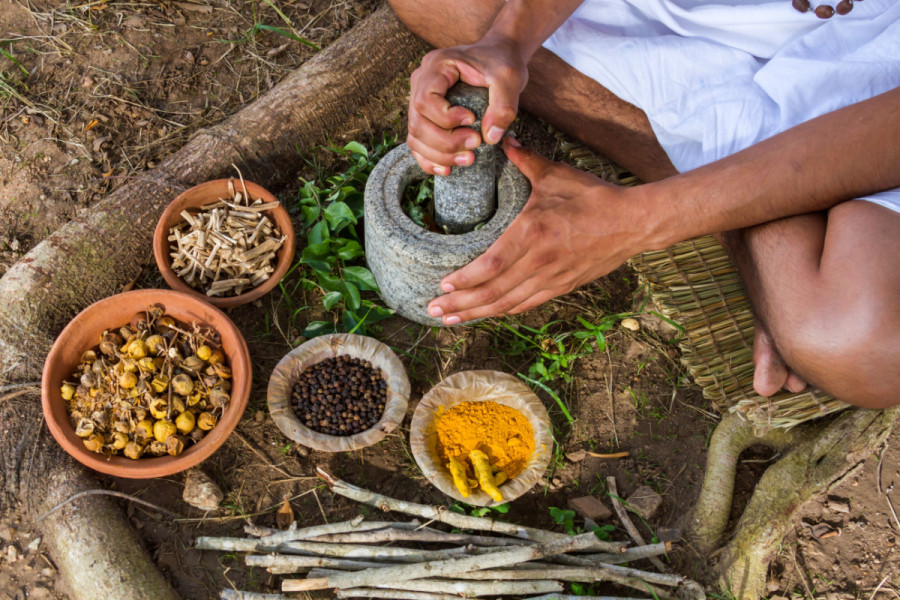Columns
Embracing traditional healing
The new discourse in contemporary Nepal sees traditional health practices as a hindrance to development.
Divya Rana
Health choices and healing practices in Nepal range from doctors, nurses, traditional birth attendants, acupuncturists, Tibetan healers, Ayurvedic practitioners and herbal doctors to spiritual healers, shamans, sokhas, lamas, guruwas, dhamis and jhakris. Health practices here emphasise the medically pluralistic nature of people's choices as a norm rather than an exception. People go through numerous treatment and healing options for the same illness like technologically advanced biomedical therapies and biopharmaceutical products to spiritual healing of the soul and faith healing through crowd hysteria and violent ecstatic rituals through capturing the demons, often referred to as “witchcraft”. While the complementary nature of these multiple forms of healing and biomedicine is accepted by people culturally and socially, the development discourse don’t.
The western-style biomedicine central to Nepalis' construction of the meaning of development perceives traditional healing practices as a hindrance to development. It emphasises the need for rural villages in Nepal to adopt urban and modern health care. The discourse was first introduced in Nepal in the 1950s after the political upheaval that ousted the Rana oligarchy. It resulted in new development policies and changes that encouraged the healthcare planners and implementers to focus on achieving development goals on a national scale for rural development. The programmes were successful in increasing accessibility to and affordability of primary health care across the country. However, they also created a polarised rural-urban dichotomy in the country whereby rural was seen as primitive, and faith of villagers in healing practices as irrational and superstitious. Meanwhile, urban life was associated with modernity and development. This polarised dichotomy has continued to shape a culture of shame around traditional healing beliefs, rituals, and practices.
What traditional healing entails
There are some fundamental social, emotional, and psychological functions that traditional healing rituals and practices hold in Nepali societies that are not addressed by modern medicine. For instance, many traditional rituals and healing practices offer a sense of belongingness and acceptance to people who seek momentary relief from their everyday problems and an escape from the chronicity of hopelessness, pain and despair. Traditional health practices and healing rituals emphasise the aspects of collective emotional healing and celebration of shared experiences of suffering through faith. Therefore, acknowledging that the traditional healing rituals and health systems have a rational function in societies would allow these practices to be perceived not as a hindrance but as a crucial component of development. While modern medicine addresses how illnesses occur, traditional healing rituals seek to address why misfortunes happen.
One of the major problems with government institutions, contemporary health care systems and biomedical authorities in Nepal is their negligence to understand complex and unique social relationships and the unending processes of despair, hopelessness, chronicity of pain and melancholy experienced by people. By addressing historical grievances, healing practices and rituals allow patients to surrender to communal coping mechanisms through faith. This enables them to create social meanings as to why misfortunes happen and why a series of illnesses occur while accepting the use of modern biomedicine to treat illnesses when needed.
Another key aspect often ignored in discussions about health, illness, and wellness concerning traditional healing rituals and practices is the celebratory aspects that bring much-needed pain relief in societies that live with sustained trauma and injustices through marginalisation and poverty. The celebratory aspect of healing rituals shows how the interplay of complex layers of historical, social, geographical, psychological, and emotional factors uniquely shapes the health culture in societies.
Even when healthcare policies and programmes acknowledge the social and political determinants of health, these programmes and policies are still focused on issues around rigid cultural beliefs, economic restrictions, financial limitations, geographical location, and lack of accessibility and affordability of western-style biomedicine and healthcare. These programmes tend to merely acknowledge the symbolic consideration of traditional practices without genuinely exploring the rationality of these traditional beliefs, knowledge, and procedures. For instance, even though traditional birth attendants and spiritual healers like shamans in some parts of Nepal are trained to be bridges between the people and the policies, the healers and ritualists are not necessarily perceived as having rational functions in societies. They are merely considered tools to achieve the western-influenced development goals introduced by international interventions that deem these traditional beliefs as irrational.
The struggle to accept traditional healing rituals and practices as rational and fundamental to certain societies like Nepal seems to be a challenge not for the people themselves but for the health actors, practitioners and implementers who resist the notion that traditional practices can be complementary, and that traditional healing knowledge and belief systems serve their own rational functions in societies.
Acknowledging traditional practices
Existing gaps in understanding the sociocultural functions of traditional healing practices and rituals need to be addressed in theory and practice while implementing health policies and developing programmes. There is a need for the government, policymakers, development workers, healthcare planners, and implementers at all levels to understand and acknowledge the rationality behind traditional healing rituals and embrace medical pluralism in Nepal. The process of combining various traditional health belief systems with western-style modern medicine in treating illnesses is practised in many societies around the world. In fact, medical pluralism is considered the rule, not the exception, worldwide by many ethnologists working in medical anthropology and global health. Acknowledging the rationality would contribute to reshaping the current flawed linear discourse by promoting a context-sensitive, locally rooted, people-centred approach to health and development in Nepal.




 8.12°C Kathmandu
8.12°C Kathmandu















